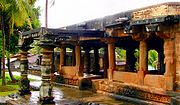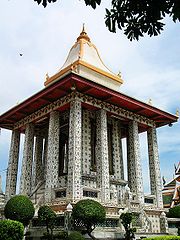
Mandapa
Encyclopedia

Indian architecture
The architecture of India is rooted in its history, culture and religion. Indian architecture progressed with time and assimilated the many influences that came as a result of India's global discourse with other regions of the world throughout its millennia-old past...
is a pillared
Column
A column or pillar in architecture and structural engineering is a vertical structural element that transmits, through compression, the weight of the structure above to other structural elements below. For the purpose of wind or earthquake engineering, columns may be designed to resist lateral forces...
outdoor hall or pavilion
Pavilion (structure)
In architecture a pavilion has two main meanings.-Free-standing structure:Pavilion may refer to a free-standing structure sited a short distance from a main residence, whose architecture makes it an object of pleasure. Large or small, there is usually a connection with relaxation and pleasure in...
for public rituals.
Temple architecture

Hindu temple
A Mandir, Devalayam, Devasthanam, or a Hindu temple is a place of worship for followers of Hinduism...
the mandapa is a porch-like structure through the (gopuram
Gopuram
A Gopuram or Gopura, is a monumental tower, usually ornate, at the entrance of any temple, especially in Southern India. This forms a prominent feature of Koils, Hindu temples of the Dravidian style. They are topped by the kalasam, a bulbous stone finial...
) (ornate gateway) and leading to the temple. It is used for religious dancing and music and is part of the basic temple compound. The prayer hall was generally built in front of the temple's sanctum sanctorum
Sanctum sanctorum
The Latin phrase sanctum sanctorum is a Latin translation of the biblical term: "Holy of Holies" which generally refers in Latin texts to the Holiest place of the Tabernacle of Ancient Israel and later the Temples in Jerusalem, but also has some derivative use in application to imitations of the...
(garbhagriha
Garbhagriha
Garbhagriha or Garbha griha is the small unlit shrine of a Hindu temple.Garbhagriha or ' is a Sanskrit word meaning the interior of the sanctum sanctorum, the innermost sanctum of a Hindu temple where resides the murti of the primary deity of the temple...
). A large temple would have many mandapas.
If a temple has more than one mandapa, each one is allocated for a different function and given a name to reflect its use. For example, a mandapa dedicated to divine marriage is referred to as a kalyana mandapa.
Often the hall was pillared and the pillars adorned with intricate carvings
Stone carving
Stone carving is an ancient activity where pieces of rough natural stone are shaped by the controlled removal of stone. Owing to the permanence of the material, evidence can be found that even the earliest societies indulged in some form of stone work....
.
In contemporary terms, it also represents a structure within which a Hindu wedding
Hindu wedding
Hindu wedding is thought to be the bringing of two people who are said to be compatible. Hindu wedding ceremonies are traditionally conducted at least partially in Sanskrit, the language of most holy Hindu ceremonies. The local language of the people involved is also used since most Hindus do not...
is performed. The Bride & Groom encircle a holy fire lit by the officiating priest in the center of the Mandapa.
Name variations
_in_panchakuta_basadi_at_kambadahalli.jpg)
- gMaha
- mandapa
- Ranga Mandapa
- Meghanath Mandapa
- Namaskara Mandapa
- Kalyana Mandapa
- Open Mandapa
- Jagamohan.
- Artha Mandapam — intermediary space between the sanctum sanctorumSanctum sanctorumThe Latin phrase sanctum sanctorum is a Latin translation of the biblical term: "Holy of Holies" which generally refers in Latin texts to the Holiest place of the Tabernacle of Ancient Israel and later the Temples in Jerusalem, but also has some derivative use in application to imitations of the...
and the temple exterior - Asthana Mandapam — assembly hall
- Kalyana Mandapam — dedicated to ritual marriage celebration of the Lord with Goddess
- Maha Mandapam — big hall for conducting religious discourses
Other languages

Tamil language
Tamil is a Dravidian language spoken predominantly by Tamil people of the Indian subcontinent. It has official status in the Indian state of Tamil Nadu and in the Indian union territory of Pondicherry. Tamil is also an official language of Sri Lanka and Singapore...
, this platform is the Aayiram Kaal Mandapam - a distinctly thousand pillared hall close to the vimana
Vimana (shrine)
Vimana is a term for the tower above the Garbhagriha or Sanctum sanctorum in a Hindu temple.-Architecture:A typical Hindu temple in Dravidian style may have multiple gopurams, typically constructed into multiple walls in tiers around the main shrine...
of the Koil
Koil
Koil or Kovil "King's House" is the Tamil term for a distinct style of Hindu temple with Dravidian architecture.The koil in Tamil Nadu and kovil of Ceylon has a long history and has always been associated with the ruler of the time. Most kings patronised temple building in their kingdom, and...
which forms a distinct part of the site plan of classical Dravidian architecture
Dravidian architecture
Dravidian architecture was a style of architecture that emerged thousands of years ago in Southern part of the Indian subcontinent or South India. They consist primarily of pyramid shaped temples called Koils which are dependent on intricate carved stone in order to create a step design consisting...
.
The Burmese
Burmese language
The Burmese language is the official language of Burma. Although the constitution officially recognizes it as the Myanmar language, most English speakers continue to refer to the language as Burmese. Burmese is the native language of the Bamar and related sub-ethnic groups of the Bamar, as well as...
term mandat , which has etymological origins in Pali mandapa, is an open platform or pavilion from which people spray water to passers-by during the Buddhist festival Thingyan
Thingyan
Thingyan is the Burmese New Year Water Festival and usually falls around mid-April . It is a Buddhist festival celebrated over a period of four to five days culminating in the new year...
.
A mandapa in Thai
Thai language
Thai , also known as Central Thai and Siamese, is the national and official language of Thailand and the native language of the Thai people, Thailand's dominant ethnic group. Thai is a member of the Tai group of the Tai–Kadai language family. Historical linguists have been unable to definitively...
is a mondop. It features often in Thai temple art and architecture
Thai Temple Art and Architecture
This article on Thai temple art and architecture discusses Buddhist temples in Thailand. A typical Thai Wat, which is loosely translated as monastery or temple, has an enclosing wall that divides it from the secular world.-Wat architecture :The architecture of a Wat has seen many changes in...
, either in the form of a Hor Trai
Hor Trai
A ho trai is the library of a Thai Buddhist temple.A ho trai can come in different shapes and sizes.For many centuries, the sacred Tripitaka scriptures had been written on palm leaves. To preserve the scriptures against humidity and against termites, the library was often built on columns to raise...
(a temple library) or as an altar shrine such as the one in Wat Chiang Man
Wat Chiang Man
Wat Chiang Man is a Buddhist temple inside the old city of Chiang Mai, in northern Thailand.-History:...
in Chiang Mai
Chiang Mai
Chiang Mai sometimes written as "Chiengmai" or "Chiangmai", is the largest and most culturally significant city in northern Thailand. It is the capital of Chiang Mai Province , a former capital of the Kingdom of Lanna and was the tributary Kingdom of Chiang Mai from 1774 until 1939. It is...
.

